dbnewton
Contributor
Well run comfortable resort with good food, great diving, interesting local culture, and friendly staff.
The resort and accommodations:
The resort has all the amenities necessary to make guests comfortable. Rooms are spacious with continuous electricity (they have their own generator which 24/7). Rooms are air conditioned with their own bathroom. Always plenty of hot water and a mini fridge that they supply with drinking water.
The meals are well prepared and there is plenty of food. They have a fixed menu that changes daily for lunch and dinner. It never repeated for the 17 days we stayed. Breakfast is continental buffet or you can order extra items for additional fee. Meals are served communally and specific scheduled times but if you are out on an excursion like diving and return late they hold the meal for you, you don't miss it.
All of the rooms are a very short walk to the central gathering area where there is a pool and a bar and the lounge with TV and books (we never saw the TV on but why would you in watch TV while on vacation in paradise?)
There are no paved roads and the local residents tend to either work for the resort, for the government, run tiny business, or subsistence hunter/gather. The locals are friendly and their craft work is extraordinary and very low cost (bargaining is expected, start by offering half of the asking price). We never exchanged any currency with a local as all the locals are willing to bill items to your room. Just negotiate your agreed price and tell the hotel and the hotel pays the local and bills you on checkout. We never felt unsafe or unwelcome and even if you buy at full retail everything is a bargain.
In addition to the diving (more below) we also tried: fishing, trips to local villages, waterfalls, & beaches. All were fun and relaxing. Good way to kill that no fly day at the end or take a break in the middle. Shop for crafts like wood masks and clubs, model canoes in the local style, woven mats and hangings, shoulder bags, hats, and shell crafts. They are all hand made locally and prices are quite reasonable.

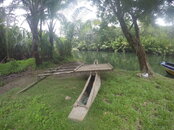
Logistics:
Tufi is quite remote, access is only via small airplane from Port Moresby via PNG Airline. We had zero issues with the flights but we did observe that the PNG flight to/from Tufi is delayed or cancelled more often than not. Travelers might want to consider an overnight in Port Moresby as buffer. Flights only Monday morning or Wednesday and Friday afternoon. Port Moresby is the capital and served by many international carriers. The resort is on a volcanic fjord sitting high on the bank overlooking the ocean on one side and the fjord on the other. Thus there is a significant hill to/from the waterfront where the dive shop (more below on diving) and water sports are. They run a couple of range rovers on demand to take you up/down the hill or if you want exercise you can walk it yourself. Power is 240V 50Hz with Australian style plugs.
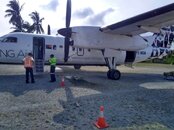
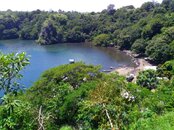
Weather:
There are three "seasons" (it's the tropics so there are no true seasons): rainy (January to mid May), windy (late May thru August), calm and dry (Sept to December). We were there in Feb and March. It did rain but almost exclusively at night. We only had rain one day during the day, yet at night it almost always rained (between midnight and 6 AM). We never got rained out of anything. There were one or two days when we could not get out to the outer reefs due to wind (it is open ocean and 5-15 miles out). But on those days we did still dive in the fjord and it is spectacular. We were told that the period from Sept to end of December is best but our experience with the rainy season was also great.
The Diving:
In a word spectacular. There is a variety of diving including wall, slope, muck, reef top, as well as a few WWII wrecks. The outer reefs rise to the surface or a couple meters below. They are typically wall or slope dives. There is little or no current. The coral is all in very good condition (not broken up by waves or divers). The fish life is abundant albeit less so than Raja Ampat in Indonesia. We saw large predators like Barracuda, Tuna, Sharks, Mackerel on most dives as well as the normal array of reef fish both small and large. The reef is well suited to macro photography as well, tiny nudibranch, egg sacks, flatworms,... There is absolutely zero trash either floating or on the reefs, they are pristine. One unique sight here is the white hammerhead shark. It is found here and one other place in the world (we were told so no reference).
The water was warm 30C/86F and very clear (greater than 30m/100' vis most reefs). They typically tie to a mooring on the reef and divers swim but they did some dives as drift dives even though there was no real current to drift on, just slowly kick along the wall. They limit dives to around 60 minutes but depending on the depth it is quite easy to exceed NDL on one dive, so watch your meter. They do NOT have nitrox, only air. They use aluminum 80 (approx). Entry is either giant stride or backward roll depending on the boat used. They were running two boats while we were there but there are more boats that could be deployed if needed. Since this is the only dive operation anywhere within at least 50 miles there is never a crowd on the reef. They can send boats to different reefs to avoid crowding. Typically they send the boats on two tank dives in the morning returning for lunch at the resort. If requested they can do three tank dives with a lunch for SI between dives 2 and 3. There is no rinse tank on the boats but they do rinse your gear at the dock. There is no camera room at the dive center, so no compressed air and no charging stations. There is a camera rinse tank.
The diving in the fjord is unique. There is very little wave or current action and thus the coral and fans and sponges that are too fragile to survive in open ocean, thrive here. The fjord is deep (greater than 45m/150'). Visibility in the fjord is far lower (10m/33')(note the difference in the pictures labeled fiord) and the fish are typically smaller (no large tuna, mackerel, sharks,..). I am not a muck diver but there are stretches of muck diver heaven between the coral banks.
We dove two wrecks, a PT boat and a P38 lightning. The PT boat is broken up since they were plywood and it burned to the waterline. The P38 is intact and in very good condition but covered in coral and sponges as you would expect for 75 years underwater. There are also a B25, and a B17 that we did not dive.
Outer Reef Examples: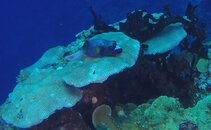
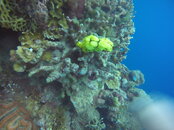
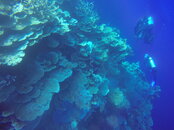
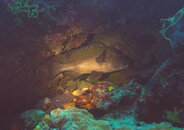
Fjord Examples: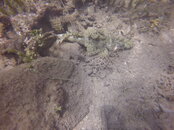
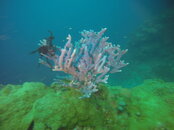
Since the top of the reefs are so shallow it is quite possible to bring snorkelers along on the diving trips. The snorkelers can hover above the reef and enjoy the snorkel while the divers below enjoy the deeper parts of the reef. They welcome snorkelers and provide guides as needed.
The resort and accommodations:
The resort has all the amenities necessary to make guests comfortable. Rooms are spacious with continuous electricity (they have their own generator which 24/7). Rooms are air conditioned with their own bathroom. Always plenty of hot water and a mini fridge that they supply with drinking water.
The meals are well prepared and there is plenty of food. They have a fixed menu that changes daily for lunch and dinner. It never repeated for the 17 days we stayed. Breakfast is continental buffet or you can order extra items for additional fee. Meals are served communally and specific scheduled times but if you are out on an excursion like diving and return late they hold the meal for you, you don't miss it.
All of the rooms are a very short walk to the central gathering area where there is a pool and a bar and the lounge with TV and books (we never saw the TV on but why would you in watch TV while on vacation in paradise?)
There are no paved roads and the local residents tend to either work for the resort, for the government, run tiny business, or subsistence hunter/gather. The locals are friendly and their craft work is extraordinary and very low cost (bargaining is expected, start by offering half of the asking price). We never exchanged any currency with a local as all the locals are willing to bill items to your room. Just negotiate your agreed price and tell the hotel and the hotel pays the local and bills you on checkout. We never felt unsafe or unwelcome and even if you buy at full retail everything is a bargain.
In addition to the diving (more below) we also tried: fishing, trips to local villages, waterfalls, & beaches. All were fun and relaxing. Good way to kill that no fly day at the end or take a break in the middle. Shop for crafts like wood masks and clubs, model canoes in the local style, woven mats and hangings, shoulder bags, hats, and shell crafts. They are all hand made locally and prices are quite reasonable.


Logistics:
Tufi is quite remote, access is only via small airplane from Port Moresby via PNG Airline. We had zero issues with the flights but we did observe that the PNG flight to/from Tufi is delayed or cancelled more often than not. Travelers might want to consider an overnight in Port Moresby as buffer. Flights only Monday morning or Wednesday and Friday afternoon. Port Moresby is the capital and served by many international carriers. The resort is on a volcanic fjord sitting high on the bank overlooking the ocean on one side and the fjord on the other. Thus there is a significant hill to/from the waterfront where the dive shop (more below on diving) and water sports are. They run a couple of range rovers on demand to take you up/down the hill or if you want exercise you can walk it yourself. Power is 240V 50Hz with Australian style plugs.


Weather:
There are three "seasons" (it's the tropics so there are no true seasons): rainy (January to mid May), windy (late May thru August), calm and dry (Sept to December). We were there in Feb and March. It did rain but almost exclusively at night. We only had rain one day during the day, yet at night it almost always rained (between midnight and 6 AM). We never got rained out of anything. There were one or two days when we could not get out to the outer reefs due to wind (it is open ocean and 5-15 miles out). But on those days we did still dive in the fjord and it is spectacular. We were told that the period from Sept to end of December is best but our experience with the rainy season was also great.
The Diving:
In a word spectacular. There is a variety of diving including wall, slope, muck, reef top, as well as a few WWII wrecks. The outer reefs rise to the surface or a couple meters below. They are typically wall or slope dives. There is little or no current. The coral is all in very good condition (not broken up by waves or divers). The fish life is abundant albeit less so than Raja Ampat in Indonesia. We saw large predators like Barracuda, Tuna, Sharks, Mackerel on most dives as well as the normal array of reef fish both small and large. The reef is well suited to macro photography as well, tiny nudibranch, egg sacks, flatworms,... There is absolutely zero trash either floating or on the reefs, they are pristine. One unique sight here is the white hammerhead shark. It is found here and one other place in the world (we were told so no reference).
The water was warm 30C/86F and very clear (greater than 30m/100' vis most reefs). They typically tie to a mooring on the reef and divers swim but they did some dives as drift dives even though there was no real current to drift on, just slowly kick along the wall. They limit dives to around 60 minutes but depending on the depth it is quite easy to exceed NDL on one dive, so watch your meter. They do NOT have nitrox, only air. They use aluminum 80 (approx). Entry is either giant stride or backward roll depending on the boat used. They were running two boats while we were there but there are more boats that could be deployed if needed. Since this is the only dive operation anywhere within at least 50 miles there is never a crowd on the reef. They can send boats to different reefs to avoid crowding. Typically they send the boats on two tank dives in the morning returning for lunch at the resort. If requested they can do three tank dives with a lunch for SI between dives 2 and 3. There is no rinse tank on the boats but they do rinse your gear at the dock. There is no camera room at the dive center, so no compressed air and no charging stations. There is a camera rinse tank.
The diving in the fjord is unique. There is very little wave or current action and thus the coral and fans and sponges that are too fragile to survive in open ocean, thrive here. The fjord is deep (greater than 45m/150'). Visibility in the fjord is far lower (10m/33')(note the difference in the pictures labeled fiord) and the fish are typically smaller (no large tuna, mackerel, sharks,..). I am not a muck diver but there are stretches of muck diver heaven between the coral banks.
We dove two wrecks, a PT boat and a P38 lightning. The PT boat is broken up since they were plywood and it burned to the waterline. The P38 is intact and in very good condition but covered in coral and sponges as you would expect for 75 years underwater. There are also a B25, and a B17 that we did not dive.
Outer Reef Examples:




Fjord Examples:


Since the top of the reefs are so shallow it is quite possible to bring snorkelers along on the diving trips. The snorkelers can hover above the reef and enjoy the snorkel while the divers below enjoy the deeper parts of the reef. They welcome snorkelers and provide guides as needed.



